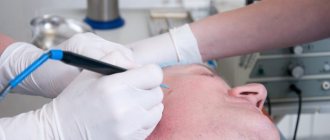Radio waves have long been used in medicine for diagnostic and therapeutic purposes; there are various devices that generate this radiation. In gynecological practice, the Surgitron device is used, with which you can remove various pathological formations and cauterize tissue. The work is based on the effect of radio waves on cells, which differs from that of electric current or laser. Most often, “Surgitron” is used to solve problems of the cervix - removal of erosions, polyps, dysplasia, etc.
Why does cervical erosion need to be removed?
Cervical erosion is a pathological ulceration of its surface. In gynecological practice, this term also often means ectopia, cicatricial deformation, eroded ectropion and some other pathological foci. The tactics of conducting all of them are approximately the same. Ignoring any such problem can lead to serious diseases, even cancer, later. Some take years to develop, while others take several months. The main consequences of erosion include the following:
- The constant presence of an inflammatory process in the cervix ultimately leads to leukoplakia, dysplasia, polyps and cancer. These processes can be combined or develop into more malignant forms.
- A chronic inflammatory process on the cervix will provoke constant colpitis (for example, candidiasis, bacterial vaginosis, etc.).
Stages of cervical erosion
- With erosion, spotting may appear during or after sexual intercourse. This is due to the fact that the vessels and cells of the cervix are subject to all kinds of influences. Even non-turbulent intimate relationships will further traumatize the surface.
- The risk of contracting HIV, hepatitis and other similar infections from a partner is higher in girls with erosions. And in the opposite direction too - from man to woman. This is explained by the fact that microbes and viruses do not have to pass through the barrier - healthy epithelium, which does not exist. They immediately enter the bloodstream.
- During childbirth, the risk of injury and rupture of the cervix with erosion is an order of magnitude higher than that of a healthy one.
- A constant inflammatory process in the cervical canal can cause infertility. The infection can penetrate further into the uterine cavity and appendages, leading to new complications and diseases.
We recommend reading the article about the consequences of cauterization of cervical erosion. From it you will learn about what happens to the cervix after erosion is eliminated, the time required for healing, as well as the rehabilitation period.
And here is more information about when it is better to cauterize erosion.
Antibacterial and antifungal suppositories
Suppositories from this group destroy pathogenic bacteria and fungi, do not allow them to multiply and thereby eliminate the cause of inflammation. The medicinal substances contained in them act locally, which is why they practically do not cause side effects and do not lead to complications from internal organs. Unlike systemic drugs, many vaginal suppositories and tablets are approved for use during pregnancy and lactation.
Among the most effective suppositories used in gynecological practice are:
"Hexicon"
Broad-spectrum antiseptic. Effective against a large number of gram-positive and gram-negative bacteria. It is used for the treatment of trichomonas and nonspecific cervicitis and colpitis that occurs against the background of erosion. Does not work against fungal infections, not effective against thrush.
The main active ingredient of Hexicon suppositories is chlorhexidine bigluconate, an antiseptic.
- Approved for use during pregnancy from the first trimester;
- Course of therapy – 10 days;
- Price – 250-300 rub.
Advantages of the Surgitron device
The operation of the Surgitron apparatus is based on radio wave effects on cells. With this radiation, tissues begin to resist, giving off large amounts of heat. As a result, intracellular fluid evaporates and the cells “collapse.” This is how the dissection (incision) and removal of pathological foci occurs. Moreover, radio waves do not propagate deep into the tissue, so nearby structures are not injured.
The main advantages of this treatment are as follows:
- Extremely low thermal damage to tissue.
If compared with DEC (diathermocoagulation), the degree of burn will be three times less, with a laser – two to three times less. This is why tissues heal better and faster. There is no rejection of such a large number of cells as with DEC, for example. This can be tracked even by the amount of discharge after the procedure.
- Healthy tissue remains undamaged.
- Cauterization using the Surgitron apparatus is not painful. This is due to the fact that radio waves simultaneously coagulate the nerve endings, and the impulse no longer comes from this place.
- Such exposure leads to the death of pathogenic flora in the lesion, which is extremely important for subsequent healing. This is a kind of local sterilizing effect.
- After cauterization with radio waves, no rough scar remains. Therefore, the method is suitable even for girls who have not yet given birth or are planning a pregnancy. The likelihood of cervical ruptures and injuries after treatment with Surgitron is minimal.
- The risk of bleeding during and after the procedure is extremely small, since coagulation of blood vessels occurs during the cauterization process.
- The procedure takes a little time - about 15 - 20 minutes.
- Surgeries using radio waves can be performed on an outpatient basis with minimal pain relief and preparation.
Watch the video about the Surgitron cauterization procedure:
Contraindications to cauterization of erosion
As with any other method, radio wave treatment should be approached taking into account all indications and contraindications. The main restrictions include the following:
- You should not perform cauterization of erosion or other manipulations with the Surgitron apparatus if there are any inflammatory diseases in the cervix, uterine cavity, or vagina. On the eve of the procedure, a comprehensive examination is carried out: a smear for flora, PCR and ELISA for STIs and others.
- It is necessary to take into account the technique of radio wave cauterization and not use it in patients with pacemakers.
- Cauterization should not be carried out either if pregnancy is suspected or during pregnancy. That is why manipulation is planned in the first half of the cycle.
- The procedure must be carried out with caution if dysplastic elements are found in the biopsy or smears from the cervix. In this situation, radio wave treatment can be used only after a thorough examination.
- Cauterization should not be performed during exacerbations of chronic diseases, as well as during acute respiratory viral infections, etc.
Radiosurgical removal in dermatology
The radio wave treatment method is widely used in dermatological practice to get rid of:
- Papillomas and warts of various localizations.
- Nevi (moles).
- Various benign formations, represented by keratomas, fibromas, lipomas and atheromas.
- Molluscum contagiosum (even in children).
- Genital warts.
Method of treatment
A radioknife treatment session takes no more than half an hour, while the device itself acts on the skin for only a couple of minutes, and sometimes less. The entire removal process consists of several main steps:
- The nurse treats the skin with an antiseptic.
- Local anesthesia is performed using a pre-selected anesthetic.
- Wait about three to five minutes for the anesthetic to take effect.
- The doctor picks up the tip of the device (a round waveguide in a loop), turns on the device itself and quite quickly removes tumors on the skin or mucous membranes. If there is a need to send material for histology, doctors cut off skin defects in one movement - at the root. If there is no such need, the specialist simply evaporates the problematic tumor layer by layer (in this case, the doctor clearly controls the depth of exposure).
- After direct removal, the specialist can smoothly smooth the wound on the skin with another waveguide—a ball waveguide. The tissues are finally smoothed and cauterized to prevent bleeding.
- After completing the removal, the doctor treats the wound and surrounding skin with an antiseptic.
Doctors make sure to give patients detailed information on how to properly care for the area where the tumor was located so that the wound heals well and scars do not appear on the skin
It is necessary to protect the wound from damage and exposure to negative factors until the crust falls off.
Contraindications
Removal of any skin tumors is not carried out if the patient has various conditions that are a contraindication to any elective surgery:
- Excessively high pressure.
- Decompensated diabetes mellitus.
- Heart attack.
- Epilepsy.
- Any inflammatory and infectious diseases.
- Herpes.
- High body temperature.
The following are contraindications to the use of radioknife on the skin:
- Various skin diseases (chronic in the acute stage and acute).
- Suspicion of malignancy of the neoplasm.
It is important to consider that the radioknife cannot be used on any part of the body if the patient has a pacemaker. When performing an intervention, it is necessary to turn off or remove all electrical devices (for example, a hearing aid, etc.).
Preparation before cauterization of erosion with Surgitron
In order for the manipulation to take place without any complications, it is necessary to undergo a certain amount of examination on the eve of cauterization. Roughly it includes the following:
- General gynecological examination to identify concomitant pathologies.
- Colposcopic examination to clarify the pathology and determine the boundaries for removal.
- Cytology smear or PAP test to exclude dysplasia, leukoplakia, and cancer.
- Screening for STIs. The minimum spectrum is chlamydia, myco- and ureaplasma, HPV and HSV.
- A smear from the posterior vaginal fornix for flora on the eve of cauterization.
- In certain situations, a biopsy becomes necessary. For example, if dysplasia is suspected or detected to clarify the depth of spread of the process and exclude cervical cancer.
- General examinations may require blood, urine, and biochemical profiles.
How is erosion treated with Surgitron?
The radio wave treatment procedure takes on average 7 - 10 minutes. It can be performed either on an outpatient basis or in a hospital setting. Surgitron should be applied to the cervix in the first half of the cycle, preferably on days 5–7. This way, before the next menstruation, the tissues will have time to heal almost completely.
Progress of the procedure
The woman lies down on the gynecological chair, as during a routine examination. Additionally, colposcopy may be performed.
After this, the external genitalia and vagina are treated with an antiseptic solution. If necessary, local anesthesia is performed (lidocaine spray or injection of medication into the cervix). In some cases, intravenous analgesia can be performed, which also does not pose a danger to the woman.
Next, the doctor selects the attachments he needs for the device (loop, knife, etc.) and performs tissue excision. Cone-shaped excision of erosion is often used, when tissue is removed as much as possible from the outside and as little as possible from the inside.
During the procedure, a woman may smell burnt meat. It occurs when tissues “melt”. With sufficient and correct pain relief, the girl does not notice any unpleasant sensations in the lower abdomen or vagina.
Restrictions after cauterization with Sulgitron
Radio wave therapy of the cervix - surgical intervention. Therefore, there is a rehabilitation period for complete healing of the cervical tissue, about a month. During this time, the following recommendations should be observed:
- It is necessary to abstain from sexual intercourse for 30 - 40 days until the cervix is completely epithelialized.
- You cannot insert tampons, douche or perform other similar manipulations.
- It is not recommended to take hot baths, go to baths, saunas, etc. for a month.
- You should limit yourself from physical activity as much as possible.
These are the main recommendations. If necessary, the doctor will indicate additional restrictions.
Consequences after cauterization of erosion with Surgitron
Cauterization of the cervix, no matter how it is performed, implies the destruction of tissue and the formation of a new layer of cells. Therefore, some consequences are inevitable during the rehabilitation period.
Discharge after cauterization
After cauterization, a woman may notice varying degrees of vaginal discharge for another 2 to 3 weeks. At first, they will be serous-hemorrhagic in nature (admixed with blood), gradually acquiring a mucous consistency, possibly with a yellowish or whitish tint.
The following indicates pathology:
- Copious bleeding. This is direct evidence of bleeding. In such a situation, it is necessary to seek emergency medical help - stitches should be placed to stop it.
- Copious purulent discharge (yellowish or greenish) that appears when an infection occurs.
Painful sensations
The appearance of pain directly depends on the woman’s sensitivity threshold. Some do not notice any discomfort at all, while others have to constantly take medications. In any case, the doctor always warns about possible pain symptoms in the lower abdomen, lower back, sacrum, etc.
In order to stop attacks, conventional anti-inflammatory and analgesic drugs are sufficient. As a rule, if such a need arises, it is only in the first days after cauterization.
Can erosion remain after cauterization?
Many women are worried whether radio wave therapy of the cervix will help get rid of the problem forever, how many times it will have to be performed. It all depends on the size of the erosion, the doctor’s experience and equipment. The following options exist:
- If the surface of the cervix is almost completely involved in the process. In this case, there is a possibility that an area of erosion will remain.
- Also, part of the lesion may remain after cauterization if the cervix has pronounced scar changes, for example, after birth ruptures.
- If the erosion after cauterization does not go away completely, most likely, the initial method was not chosen entirely correctly, and something more radical should have been chosen.
In most cases, it is possible to completely remove the eroded surface and subsequently forget about the disease.
Will cervical erosion return?
An exciting question is when to do cauterization so that you don’t have to do it again. Cervical erosion may return again in the following situations:
- After childbirth, as new tears and deformations may appear, which will contribute to the formation of erosion.
- After injuries, for example, if curettages, abortions, etc. are performed repeatedly.
- If the entire eroded surface was not initially removed.
OPTIONAL CONDITIONS
ABC" ROOM RESULTS. RESULTS, RESULTS ¾ÑÑологиÑеÑÐºÐ°Ñ ÑÑÑÑкÑÑÑа ѻабоÑаÑоÑнÑм оп¸Ñан ием. registry, registry ¾Ð³Ð°ÑÑ Ð¾Ð¿ÑеделиÑÑ ÑÑд ÑкÑининговÑÑ ÑеÑÑов ÑоР¿ÑÑÑÑвÑÑÑи Ñ Ð¿Ð°Ñологий:
- RESULTS. ТÑнÑÑÐ°Ñ Ð² пÑомежноÑÑи, над лобком.
- ROOM Ñ ÑазвиÑÑÑÑ ÐºÑовоÑеÑение.
- RESULTS: CONDITIONS: CONDITIONS, CONDITIONS ¸Ñомониаз), пÑозÑаÑнÑе (микоплаР·Ð¼Ð¾Ð·).
- ROOM regurgitation.
- RESULTS: ASSURANCE, CONDITION °Ð±Ð¾ÑÑÑ, зловоннÑе бели, заÑÑÑдненное моÑеР¸ÑпÑÑкание, SOSÑÐ.”
RESULTS ¾ÑеÑвикоз, Ñак и ее злокаÑеÑÑвеннÑе оÑложн ениÑ. registry, не ÑвÑзанное Ñ Ð¼ÐµÑÑÑнÑми. RESULTS ROOM °ÐºÑеÑий ÑеÑез ÑеÑÐ²Ð¸ÐºÑ Ð¸ вÑзвавÑÐ¸Ñ Ð²Ð¾Ñпален › â аднекÑиÑ, Ð²Ð°Ð³Ð¸Ð½Ñ â вÑлÑвовагиниÑ.
RESULTS 23-25%, RUR 23-25% ¾Ð¶Ð½ÑÑÑÑÑÑ 85%. RESULTS, " 100 %. RESULTS ok, ok, ok. 12 12 12 и ÑÑоиÑе на ÑÑеÑе, 1 Ñаз в поÐ"года иÐ" ›
RESULTS ASSURANCE, RESPONSIBILITY ¸. ROOM 2 ROOM ROOM I'm sorry.
- 12 526 зии RESEARCH нике. 211 ¾ Ñам им не Ñмогли п омоÑÑÑ. RESULTS, наÑей клинике
- RESULTS ие, но и единÑÑÐ²ÐµÐ½Ð½Ð°Ñ Ð² РоÑÑии клинР¸ÐºÐ° Ñо Ñвоей авÑоÑÑкой пÑогÑаммой.










